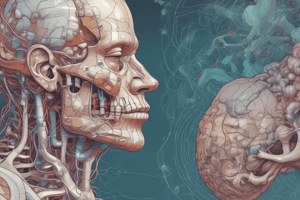Podcast
Questions and Answers
What is hypoxia defined as?
What is hypoxia defined as?
- Complete absence of oxygen in the tissues
- Increased oxygen level in the tissues
- Lack of oxygen at the tissue level (correct)
- Normal oxygen level in the tissues
What is anoxia defined as?
What is anoxia defined as?
- Increased oxygen level in the tissues
- Lack of oxygen at the tissue level
- Normal oxygen level in the tissues
- Complete absence of oxygen in the tissues (correct)
What type of hypoxia is characterized by low arterial pO2?
What type of hypoxia is characterized by low arterial pO2?
- Stagnant (ischaemic) hypoxia
- Anaemic hypoxia
- Histotoxic hypoxia
- Hypoxic hypoxia (correct)
What is the cause of anaemic hypoxia?
What is the cause of anaemic hypoxia?
What is the cause of stagnant (ischaemic) hypoxia?
What is the cause of stagnant (ischaemic) hypoxia?
What is the cause of histotoxic hypoxia?
What is the cause of histotoxic hypoxia?
What is a clinical feature of hypoxia?
What is a clinical feature of hypoxia?
What is a cause of hypoxic hypoxia?
What is a cause of hypoxic hypoxia?
Flashcards are hidden until you start studying
Study Notes
Hypoxia
- Defined as a lack of oxygen at the tissue level
- Different from anoxia, which is a complete absence of oxygen in the tissues
Types of Hypoxia
- Classified into four groups:
Hypoxic Hypoxia
- Characterized by low arterial pO2 despite normal or elevated oxygen carrying capacity of blood and rate of blood flow to tissues
- Causes:
- Low pO2 of inspired air
- Decreased pulmonary ventilation
- Defect in exchange of gases
- Venous arterial shunts (Right to left shunt)
- Ventilation-perfusion imbalance (including increased physiological dead space and physiological shunt)
Anaemic Hypoxia
- Characterized by normal arterial pO2 but reduced amount of haemoglobin available to carry oxygen
- Causes:
- Anaemia
- Haemorrhage
- Conversion of haemoglobin to some abnormal form (e.g. met haemoglobin, carboxyhemoglobin)
Stagnant (Ischaemic) Hypoxia
- Blood flow to the tissue is too low to deliver adequate oxygen despite normal arterial pO2 and haemoglobin concentration
- Causes:
- General slowing of the circulation (e.g. heart failure, shock)
- Local slowing (e.g. vasoconstriction, cold, arterial wall spasm)
- Haemorrhage
Histotoxic Hypoxia
- Amount of oxygen delivered to the tissues is adequate, but tissues cannot make use of the oxygen due to toxic agents inhibiting oxidative enzyme activity
- Cause:
- Cyanide poisoning, which damages the enzyme cytochrome oxidase
Effects of Hypoxia
- Can lead to impairment of judgment, and other clinical features, depending on the degree of hypoxia
Studying That Suits You
Use AI to generate personalized quizzes and flashcards to suit your learning preferences.




